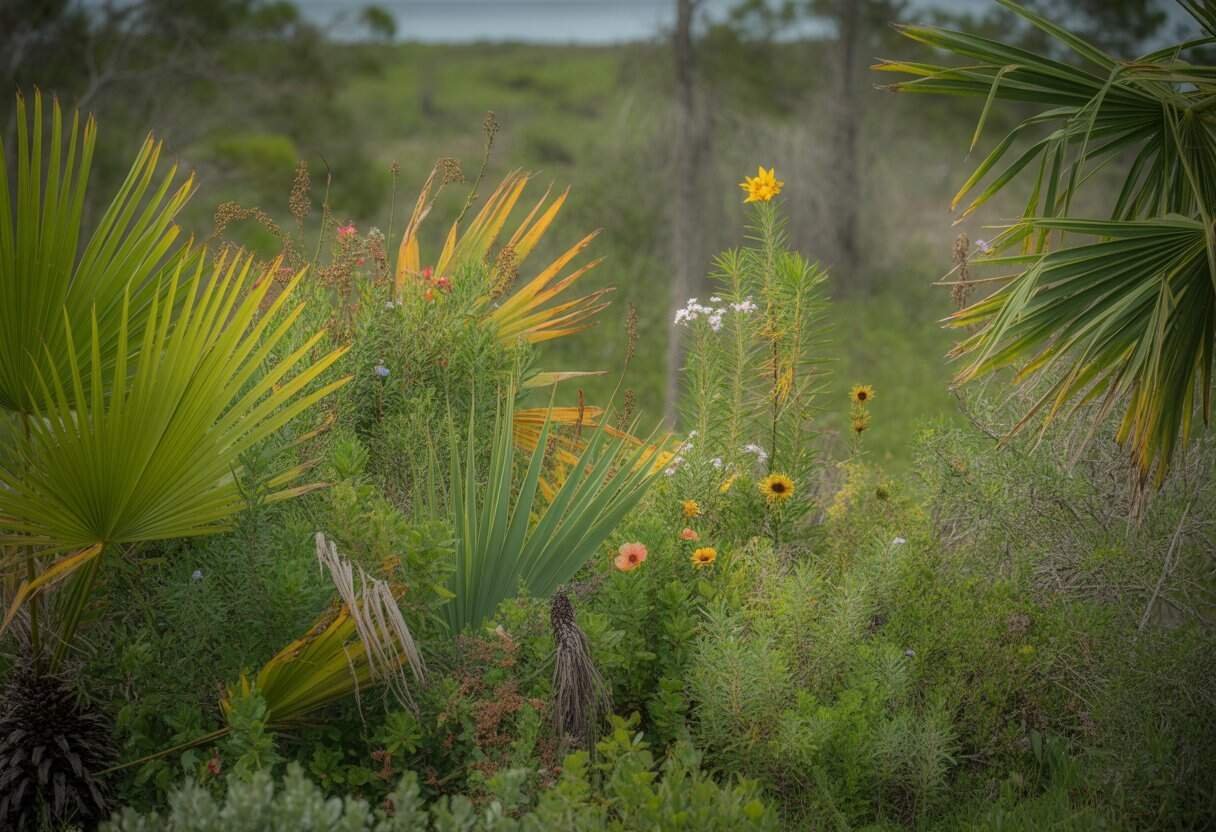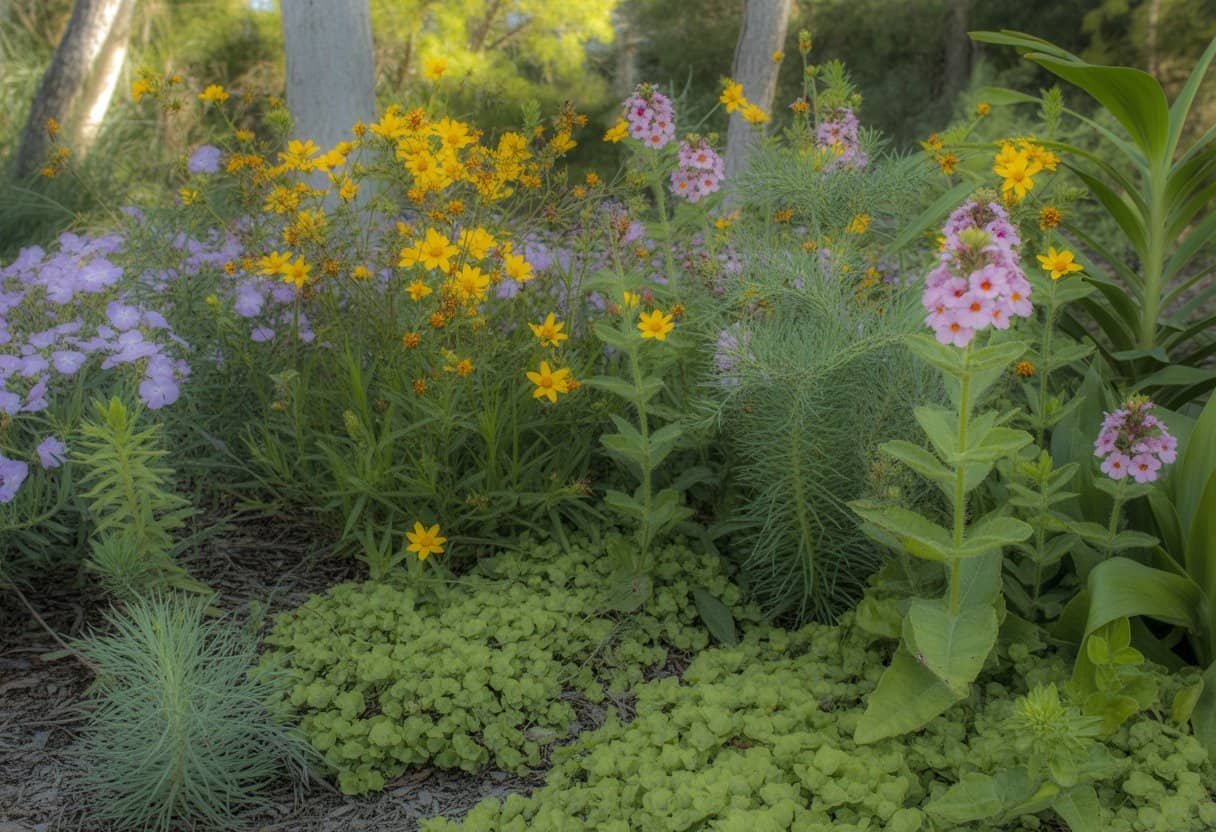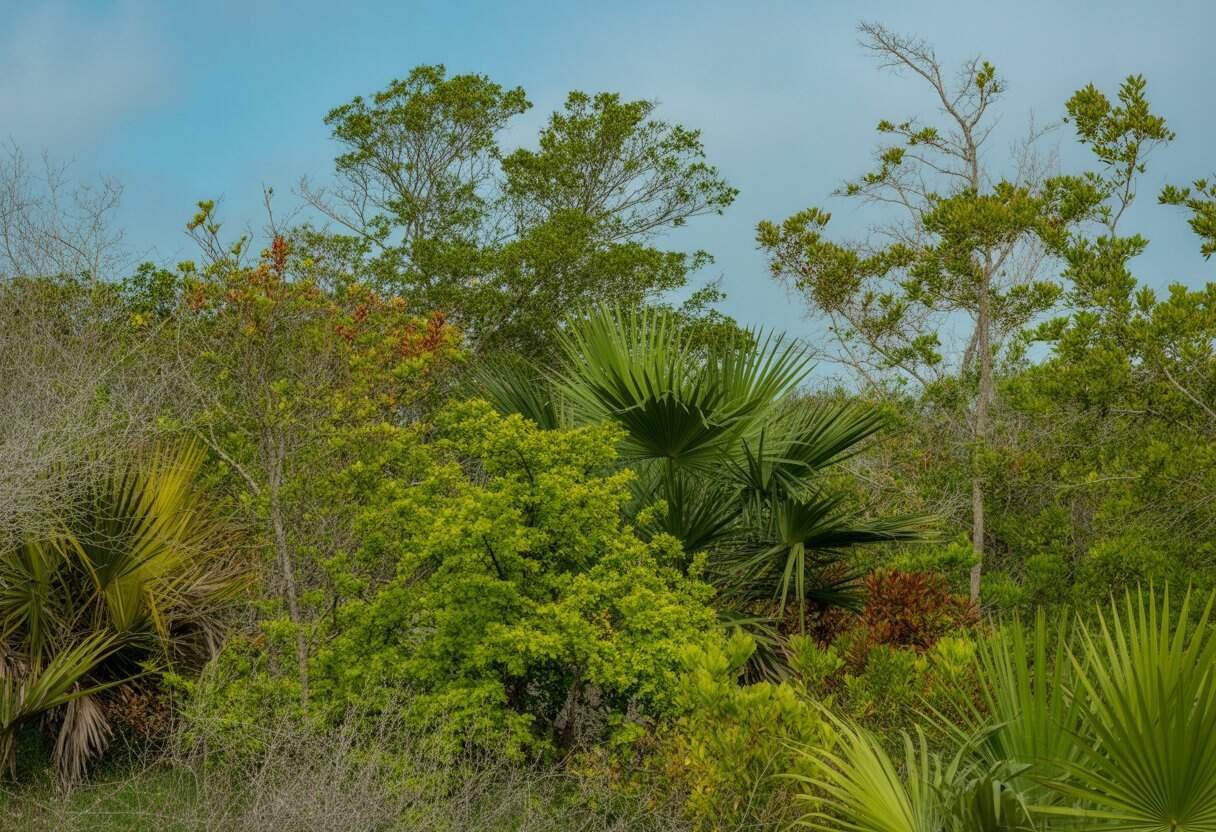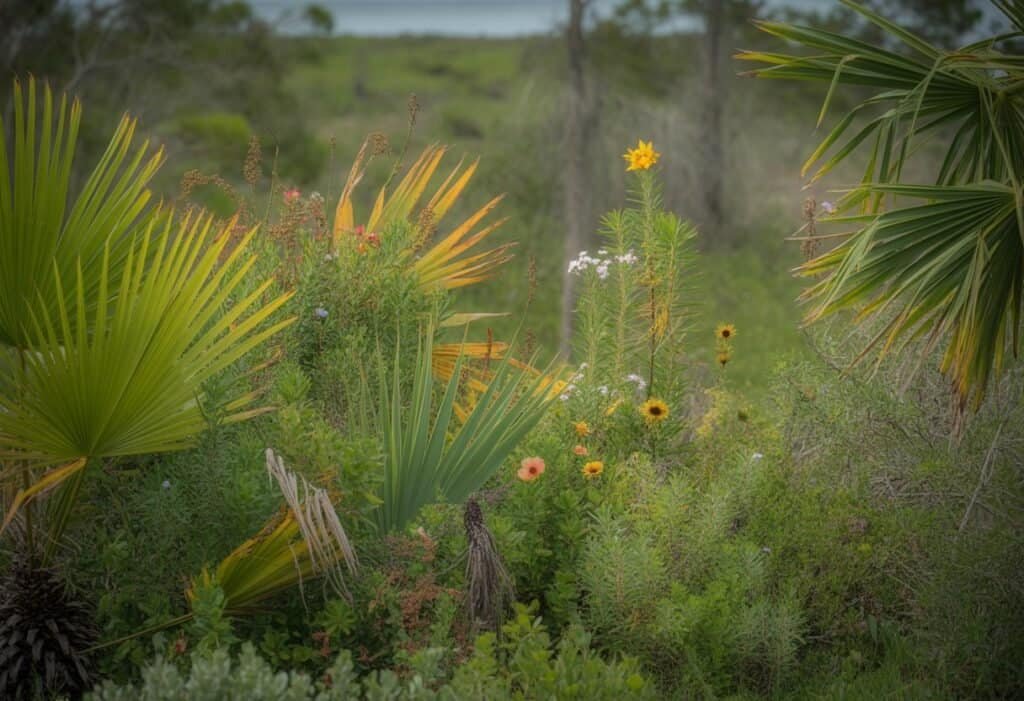Florida native plants bring beauty and benefits that non-native species can’t match. These plants evolved in our unique climate, thriving with minimal water and maintenance while supporting local wildlife.
They create habitats for butterflies, birds, and bees that have relied on these plants for thousands of years.

Choosing Florida native plants for your garden helps conserve water and reduce the need for fertilizers. These plants have adapted to Florida’s sandy soils, periodic droughts, humid summers, and occasional freezes.
Native plants are remarkably resilient once established.
When you plant natives, you help rebuild the ecological web that makes Florida special. From the vibrant blooms of coreopsis to the presence of live oaks, native plants bring the real Florida right to your doorstep.
Key Takeaways
- Florida native plants need less water, fertilizer, and maintenance than exotic species while supporting local wildlife.
- Native plants thrive in Florida’s unique climate and soil conditions and are naturally resilient.
- Gardening with native plants helps preserve Florida’s natural heritage and ecological balance.
Understanding Florida Native Plants
Florida’s native plants evolved over thousands of years to thrive in the state’s unique conditions. These plants form the backbone of local ecosystems and provide many benefits when used in landscapes.
What Makes a Plant Native to Florida
Native plants are species that grew naturally in Florida before European colonization. These plants adapted to the local soil, rainfall, and temperature changes over thousands of years.
They developed natural defenses against local pests and diseases. Native plants have deep genetic ties to Florida’s environment.
Some examples include saw palmetto, coontie, muhly grass, and firebush.
Florida native plants vary across the state. Plants native to the Panhandle may struggle in the Keys due to different climate conditions.
When choosing natives for landscaping, select plants suited to your specific region within Florida. Many nurseries now specialize in native plants, making them easier for home gardeners to find.
Benefits of Native Flora
Florida native plants need much less maintenance once established. They usually need less water, fertilizer, and pesticides than non-native species.
Environmental Benefits:
- Provide food and habitat for local wildlife
- Support pollinators like butterflies and bees
- Reduce water pollution from fertilizer runoff
- Help prevent soil erosion
Landscape Benefits:
- Lower maintenance costs
- Increased drought tolerance
- Better resistance to local pests
- Connect homeowners to Florida’s natural heritage
Native plants also help conserve biodiversity. As development spreads across Florida, home gardens with native plants create important wildlife corridors and habitat islands.
Florida’s Distinct Ecosystems
Florida contains many diverse ecosystems despite being mostly flat. Each ecosystem supports specialized native plant communities.
Pine Flatwoods: Longleaf, slash, or pond pines with saw palmetto understory dominate these fire-dependent systems. They once covered much of Florida.
Coastal Areas: Salt-tolerant plants like sea oats and railroad vine stabilize dunes and handle harsh conditions.
Wetlands: Cypress swamps and marshes feature plants adapted to periodic flooding, such as cypress trees, pickerelweed, and swamp lily.
Scrub Habitats: Florida’s ancient desert-like areas support unique plants like scrub oak and Florida rosemary that thrive in sandy soil.
Understanding these ecosystems helps gardeners choose the right native plants for their area.
Popular Native Flowers and Groundcovers

Florida’s native flowering plants add color to gardens and support local wildlife. These low-maintenance options thrive in Florida’s climate and need less water once established.
Wild Petunia and Blue-Eyed Grass
Wild Petunia (Ruellia caroliniensis) produces lavender-blue trumpet-shaped flowers that bloom from spring through fall. This hardy perennial grows 1-2 feet tall and adapts to various light conditions.
Blue-Eyed Grass (Sisyrinchium angustifolium) isn’t actually a grass but a member of the iris family. It features star-shaped blue flowers with yellow centers that appear in spring.
Growing just 6-12 inches tall, it works well in borders and rock gardens. Spiderwort (Tradescantia ohiensis) adds three-petaled purple-blue flowers that open in the morning.
This easy-growing native reaches 2-3 feet tall and tolerates both dry and moist conditions.
Dune Sunflower, Tickseed, and Black-Eyed Susan
Dune Sunflower (Helianthus debilis) brightens coastal areas with yellow daisy-like flowers year-round. This drought-tolerant groundcover spreads 2-4 feet and helps stabilize sandy soils.
Tickseed (Coreopsis) is Florida’s state wildflower, known for its cheerful yellow blooms. Several native species exist, including Coreopsis lanceolata, which grows 1-2 feet tall and flowers from spring through summer.
Black-Eyed Susan (Rudbeckia hirta) has golden petals surrounding a dark center. This butterfly magnet blooms from summer through fall and reaches 2-3 feet tall.
It self-seeds easily, creating naturalized patches in sunny areas.
Blazing Star, Milkweed, and Porterweed
Blazing Star (Liatris spicata) produces striking purple flower spikes that bloom from top to bottom. This pollinator favorite grows 2-4 feet tall and thrives in full sun.
Its vertical form adds dramatic height to gardens. Milkweed (Asclepias) is the essential host plant for Monarch butterflies.
Florida native species include Butterfly Weed (Asclepias tuberosa) with orange flowers and Swamp Milkweed (Asclepias incarnata) with pink blooms. Porterweed (Stachytarpheta jamaicensis) attracts butterflies with its slender spikes of small blue flowers.
This low-maintenance perennial grows 2-3 feet tall and blooms nearly year-round in frost-free areas. It pairs well with native Salvia species for a butterfly-friendly garden.
Florida Native Shrubs and Trees

Florida offers a wide range of native shrubs and trees that thrive in its climate. These plants provide habitat for wildlife and need less maintenance than non-native species.
Firebush and Wild Coffee
Firebush (Hamelia patens) is a native shrub with vibrant orange-red tubular flowers that bloom year-round in South Florida. It grows 5-10 feet tall and attracts hummingbirds and butterflies.
Firebush adapts well to various soil conditions and tolerates drought once established. Wild Coffee (Psychotria nervosa) has glossy green leaves and small white flowers that turn into red berries.
Growing 4-6 feet tall, it thrives in partial shade to shade. Both shrubs are excellent for wildlife gardens.
They provide natural food sources for birds and shelter for small animals. These shrubs require little maintenance and resist drought once established.
Gumbo Limbo and Lignum Vitae
Gumbo Limbo (Bursera simaruba), known as the “Tourist Tree” for its peeling red bark, can reach 60 feet tall. This fast-growing tree thrives in coastal areas and resists hurricanes thanks to its flexible branches.
Lignum Vitae (Guaiacum sanctum) is one of the world’s hardest woods. This slow-growing tree produces blue flowers and yellow-orange fruits.
It usually grows 15-20 feet tall in landscapes. Gumbo Limbo drops its leaves during droughts to save water.
Lignum Vitae, now rare in the wild, is protected and makes a striking specimen tree in South Florida.
Marlberry, Dahoon Holly, and Live Oak
Marlberry (Ardisia escallonioides) grows 6-15 feet tall and produces clusters of white flowers followed by purple-black berries. It thrives in partial shade and works well as an understory plant.
Dahoon Holly (Ilex cassine) grows 20-30 feet tall and has bright red berries that last through winter. Female trees produce berries when male trees are nearby.
Live Oak (Quercus virginiana) is Florida’s iconic tree, growing up to 60 feet tall with a spread over 100 feet. These majestic trees can live for centuries.
Wildlife Value:
- Marlberry: Berries attract birds
- Dahoon Holly: Winter food source for birds
- Live Oak: Supports over 500 caterpillar species and provides acorns for wildlife
Walter’s Viburnum and Shortleaf Fig
Walter’s Viburnum (Viburnum obovatum) is a versatile shrub growing 6-25 feet tall depending on the variety. It produces clusters of tiny white flowers in late winter.
Compact varieties make excellent hedges or foundation plants. Shortleaf Fig (Ficus citrifolia) is a native fig tree reaching 40-50 feet tall.
It produces small red fruits that attract birds and other wildlife. This tree develops a broad, rounded crown and sometimes aerial roots.
Walter’s Viburnum thrives in sun or part shade and tolerates periodic flooding. Shortleaf Fig grows best in full sun and tolerates moderate drought once established.
Attracting Wildlife with Native Plants
Florida native plants create ideal environments for local wildlife by offering food, shelter, and breeding grounds. These natural relationships evolved over thousands of years, making native plants essential for sustaining local ecosystems.
Creating Habitats for Birds
Florida’s native plants attract many bird species by providing critical resources. Trees like Southern Live Oak and Bald Cypress offer nesting sites and protection from predators.
Birds depend on these established canopies for raising their young. Native berries and fruits serve as important food sources.
Beautyberry, Dahoon Holly, and Walter’s Viburnum produce berries that birds eat, especially during migration. These plants offer essential nutrition when birds need it most.
Seed-producing natives like Muhly Grass and Purple Coneflower attract seed-eating birds such as cardinals and finches. The natural seed cycle ensures food is available year-round.
Water-loving plants like Pickerelweed create habitat for wading birds and waterfowl. These plants support small fish and insects that birds eat.
Supporting Butterflies and Pollinators
Native wildflowers are essential for butterflies and other pollinators. Plants like Blanketflower, Firebush, and Butterfly Weed provide nectar for adult butterflies and serve as host plants for caterpillars.
Monarch butterflies rely on Milkweed varieties native to Florida. These plants provide food and places for monarchs to lay eggs.
Native flowering shrubs extend blooming seasons, ensuring nectar is available all year. Saw Palmetto and Simpson’s Stopper produce flowers that attract many pollinator species.
Consider these top Florida native plants for pollinators:
- Coral Honeysuckle: Attracts hummingbirds and butterflies
- Beach Sunflower: Provides pollen for native bees
- Tropical Sage: Blooms nearly year-round for consistent nectar
Encouraging Other Local Wildlife
Florida’s native plants support diverse wildlife beyond birds and butterflies. Dense shrubs like Wax Myrtle and Coontie create protective cover for small mammals such as rabbits and squirrels.
These plants offer shelter from predators and harsh weather. Fruit-bearing natives attract opossums, raccoons, and foxes, who help disperse seeds throughout the environment.
This process helps regenerate plant communities across landscapes. Native grasses and groundcovers provide habitat for beneficial reptiles like skinks and anoles.
These creatures help control pest populations in gardens naturally. Incorporating water features near native vegetation creates complete ecosystems.
Small ponds surrounded by native wetland plants attract frogs, turtles, and dragonflies. These microhabitats enhance biodiversity in even small garden spaces.
Native Plant Gardening and Landscaping
Creating a garden with Florida native plants offers many benefits for homeowners and the environment. Native plants require less water, fertilizer, and maintenance.
They provide habitat for local wildlife and help preserve Florida’s natural heritage.
Designing a Florida-Friendly Landscape
Start your native landscape by mapping your yard’s sun exposure, soil type, and moisture levels. Group plants with similar needs together to maximize success.
Choose plants that match your yard’s conditions instead of trying to change the environment. Native trees like Live Oak and Bald Cypress provide shade and structure.
Understory plants such as Coontie, Beautyberry, and Wild Coffee fill middle spaces. Groundcovers like Sunshine Mimosa and Beach Sunflower work well for open areas.
Layer your plants to create visual interest and mimic natural Florida ecosystems. Consider mature sizes when planning to avoid overcrowding.
Plant Selection Tips:
- Choose species native to your specific region of Florida
- Include plants that flower at different times of year
- Mix textures and heights for visual appeal
- Select salt-tolerant species for coastal properties
Maintenance Tips for Native Gardens
Native gardens need less maintenance than traditional landscapes but still require some care. Mulch beds with pine straw or leaves to suppress weeds and retain moisture.
Apply 2-3 inches of mulch but keep it away from plant stems. Prune only to remove dead or diseased growth.
Native plants often look best in their natural form. Avoid chemical pesticides that harm beneficial insects.
Most native plants have natural defenses against local pests. When problems occur, use targeted organic solutions or introduce beneficial insects.
Established native plants need little fertilizer. If needed, use a slow-release organic fertilizer once yearly.
Too much fertilizer causes weak growth and can pollute waterways. Remove invasive exotic plants that compete with natives.
Common invaders include Brazilian Pepper, Air Potato, and Japanese Climbing Fern.
Waterwise Practices and Irrigation
Most Florida natives thrive with rainfall alone once established. New plantings need regular watering for the first 6-12 months.
Water deeply but infrequently to encourage deep roots. Group plants by water needs (hydrozoning) for efficient irrigation.
This practice prevents overwatering drought-tolerant species while ensuring thirstier plants get enough moisture. Use soaker hoses or drip irrigation to deliver water directly to root zones.
These systems use less water than sprinklers and keep foliage dry, reducing disease. Rain barrels collect free water for gardens during dry periods.
A single 55-gallon barrel can collect 1,000 gallons annually from a typical roof.
Consider these additional water-saving techniques:
- Apply mulch to reduce evaporation
- Install rain sensors on irrigation systems
- Water early morning to reduce evaporation
- Collect air conditioner condensate for garden use
Finding and Sourcing Florida Native Plants
Finding the right sources for Florida native plants can make your gardening project successful. Quality plants from reputable sellers will establish better in your landscape.
Choosing the Right Plant Nursery
Native plant nurseries specialize in plants that naturally grow in Florida’s ecosystems. These nurseries offer plants better adapted to local conditions than those at general garden centers.
Look for nurseries that grow their plants from locally sourced seeds or cuttings. This ensures the plants are adapted to Florida’s climate and soil.
Ask nursery staff about their growing practices. The best native plant nurseries avoid chemical pesticides and fertilizers.
Many reputable nurseries are members of the Florida Association of Native Nurseries (FANN). Visit during different seasons to see the selection available throughout the year.
Some native plants are only available during specific growing periods.
Garden Centers and Local Resources
Local garden centers sometimes carry sections dedicated to Florida native plants. These can be convenient options when specialty nurseries are not nearby.
Resources to check:
- County extension offices
- Master Gardener programs
- Local botanical gardens
- Native plant society chapters
Many botanical gardens host annual native plant sales with experts on hand to provide advice. These events offer chances to find uncommon native species and get guidance on plant selection.
Community college horticulture programs sometimes operate small nurseries with native plants. These can be hidden gems for finding affordable native plants while supporting education.
Trusted Native Plant Nurseries
Florida has several well-established native plant nurseries with strong reputations for quality and expertise.
Top-rated Florida native plant nurseries:
- Florida Native Plants Nursery (Sarasota)
- Green Seasons Nursery (Parrish)
- Native Tree Nursery (Miami)
- Wilcox Nursery & Landscape (Largo)
- The Natives, Inc. (Davenport)
Many of these nurseries offer online catalogs so you can browse their inventory before visiting. Some also provide mail-order services for those who cannot visit in person.
Ask about guarantees when purchasing plants. Quality nurseries often offer replacement policies for plants that do not thrive when properly cared for.
Promoting Stewardship and Education
Florida’s unique native plant heritage needs active conservation efforts through education and community involvement. Several organizations work to build public awareness and protect these ecological treasures.
The Role of the Florida Native Plant Society
The Florida Native Plant Society (FNPS) serves as the state’s main advocate for native plant conservation. Founded in 1980, this non-profit organization now includes over 35 chapters throughout Florida.
FNPS protects and restores native plant communities through research, education, and advocacy. Their mission includes preserving biodiversity and native plant habitats against threats from development and invasive species.
Members gain access to expert knowledge, field trips, and workshops about Florida’s native flora. The society also hosts an annual conference where researchers, gardeners, and conservation professionals share findings and techniques.
FNPS chapters organize local plant sales, making native species more accessible to home gardeners. Their volunteer programs offer hands-on restoration experiences at parks and natural areas.
Educational Programs and Conservation
Educational programs across Florida help citizens understand the importance of native plants. Schools increasingly create native plant gardens as outdoor classrooms.
Many universities offer specialized courses in Florida native plant identification and ecology. These programs train future conservation professionals and landscape architects in sustainable practices.
Key Educational Resources:
- Extension offices providing free workshops
- Master Gardener programs with native plant specializations
- Online webinars about regional plant communities
- Field guides specific to Florida’s ecological regions
Community colleges partner with conservation organizations to create certificate programs in native landscaping. These practical skills help professionals use more sustainable practices.
Public libraries often host seed exchanges and lecture series about native plants. These free resources make native plant knowledge accessible to all.
Native Plants in Florida State Parks
Florida’s 175 state parks serve as living showcases for native plant communities. These protected areas preserve examples of Florida’s diverse ecosystems, from coastal dunes to inland forests.
Park rangers lead interpretive walks highlighting the ecological importance of native species. Many parks maintain demonstration gardens that inspire visitors to grow natives at home.
Visitor centers display educational exhibits about plant adaptations to Florida’s unique conditions. These resources help the public recognize native species in wild settings.
Several parks, including Paynes Prairie and Highlands Hammock, feature boardwalks through pristine plant communities. These accessible trails let visitors experience native habitats without causing damage.
Park volunteer programs engage citizens in removing invasive plants and restoring native vegetation. This hands-on stewardship creates personal connections to Florida’s botanical heritage.
Frequently Asked Questions
Florida native plants offer many benefits for your garden and landscape. These plants have adapted to local conditions over thousands of years, making them resilient and low-maintenance.
Which native plants are best for landscaping in Florida?
Top choices for Florida landscaping include Coontie (Zamia integrifolia), Muhly Grass (Muhlenbergia capillaris), and Firebush (Hamelia patens). These plants need minimal water once established and tolerate Florida’s climate extremes.
Saw Palmetto (Serenoa repens) works well as a foundation plant with its fan-shaped fronds and ability to thrive in many light conditions. For ground cover, consider Sunshine Mimosa (Mimosa strigillosa) with its pink powder-puff flowers and drought tolerance.
Florida natives like Simpson’s Stopper (Myrcianthes fragrans) and Walter’s Viburnum (Viburnum obovatum) make excellent hedges that support local wildlife.
What are some common native flowers found in Florida?
Blanketflower (Gaillardia pulchella) displays vibrant red and yellow blooms that attract butterflies most of the year. Coreopsis, Florida’s state wildflower, comes in several species with bright yellow flowers.
Beach Sunflower (Helianthus debilis) produces yellow flowers year-round and thrives in sandy soils. Butterfly Weed (Asclepias tuberosa) features orange flowers that serve as crucial monarch butterfly habitat.
Blue Mistflower (Conoclinium coelestinum) creates blue-purple blooms in fall. Tropical Sage (Salvia coccinea) offers red, pink, or white tubular flowers that hummingbirds love.
Where can I purchase native plants in Florida?
Native plant nurseries exist throughout Florida, with specialized businesses in most regions. The Florida Association of Native Nurseries (FANN) maintains a directory of reputable sellers.
Many county extension offices host seasonal native plant sales with experts available to provide advice. The Florida Native Plant Society chapters often organize plant sales as fundraisers.
Some conventional garden centers now maintain native plant sections, though selection may be limited compared to specialized nurseries.
How can I identify native plants in Florida?
Field guides specific to Florida flora provide detailed descriptions and photos to help with identification. The University of Florida’s IFAS Extension website offers free plant identification resources.
Mobile apps like iNaturalist and PlantNet use photo recognition to help identify plants. Upload a clear image of the plant, and these tools provide possible matches.
Local nature centers often offer guided walks where naturalists point out native species and explain their features.
Can you recommend any nurseries specializing in native Florida plants?
Green Seasons Nursery in Parrish offers a wide selection of native trees, shrubs, and perennials. Florida Native Plants Nursery in Sarasota specializes in wildlife-supporting species with knowledgeable staff.
Native Nurseries in Tallahassee has served North Florida since 1980 with quality native plants and restoration expertise. In South Florida, Silent Native Nursery in Fort Lauderdale focuses on plants suited for tropical conditions.
The Natives, Inc. in Davenport supplies plants for both residential landscapes and large restoration projects.
What are the most suitable native plants for creating privacy in Florida gardens?
Wax Myrtle (Myrica cerifera) grows quickly to form dense screens up to 20 feet tall. Its aromatic foliage adds interest to the garden.
Simpson’s Stopper forms a privacy hedge at 8-15 feet. It produces fragrant flowers and berries that attract wildlife.
Walter’s Viburnum works well as a small tree or a pruned hedge. In spring, it displays clusters of white flowers.
Southern Red Cedar (Juniperus virginiana) gives year-round screening. Its blue berries attract birds.
For smaller spaces, you can train Firebush as a hedge. Its tubular red-orange flowers attract hummingbirds.


